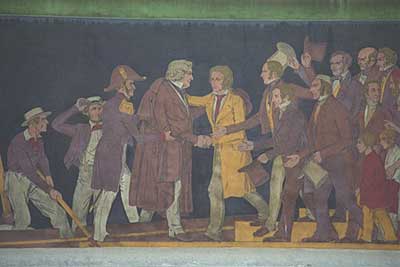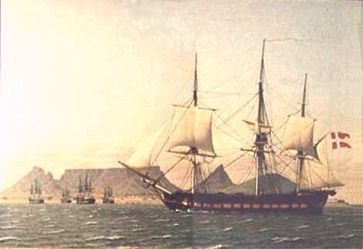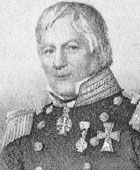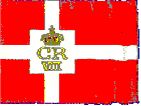|
You are here: 4Campaigns & Battles4Index4Reconstructing the Navy |
||||||||||||||||||||||||||||||||||||||||||||||||||
|
Reconstructing the Navy 1814-1848:
Norway was Lost,
|
|||||||||||||||||||||||||||||||||||||||||||||||||
|
Denmark's military had to be rebuilt and the navy was first in line. In 1815, a plan was agreed on which stated that Denmark in the future was to have six ships of the line, eight frigates, eight corvettes or brigs and eighty gun-boats. Economic means were spare, not in the least after the national bankruptcy in 1813, and it would take many years before the goal was reached. Further, the plan’s scope removed Denmark from the ranks of naval powers with international influence. The implementation of the reconstruction was placed in the hands of Captain A. Schifter, who would oversee, through the coming years, the building of six ships of the line, six frigates, 14 smaller ships and 37 gunboats. |
The navy's reconstruction |
Financing was tight and the navy could not afford to build ships and at the same time equip and sail with them.
Only guard ships in Oresund and the Great Belt were manned constantly, and for many years, only one frigate or corvette was equipped to carry out the annual cadet cruise.
The ships stationed by the Danish West Indies could only be maintained through a surtax placed on each barrel of sugar.
Education
To maintain the naval officers' education and training, many of them were allowed to sail in the merchant marine and serve in foreign navies, not in the least the French Navy.
In this manner many of the Navy's officers received not only necessary experience in sailing but also battle training. However, the rest of the Navy's personnel were sadly in lack of training possibilities.
Until 1825, all training took place on cadetships in Danish territorial waters. First in 1826 the corvette NAJADEN was sent on a training cruise north around Scotland, west past Ireland and back through the English channel to Denmark.
During the following years, the cadetship was often abroad on cruises to The Farrow Islands, Iceland and, occasionally, to the Mediterranean.
Not until the launching of the last of the eight planned frigates, the BELLONA, and the sixth ship-of-the-line, the CHRISTIAN VIII, was the Navy able to afford the equipping of the rest of its ships.
-1374-1978-n.jpg)
Ship-of-the-line
CHRISTIAN VIII was launched in 1840 as the last of the new ships of the
line to be included the Navy's reconstruction.
(Picture from The Royal
Danish Naval Museum's archive)
Improved navigation
Along with the increased shipping traffic in the Danish territorial waters, a much-needed improvement of the buoying was effectuated.
When lieutenant commander C. C. Zahrtmann, in 1826, became managing director of the Hydrographic Department, a systematized survey of the Danish territorial waters began as well as the publishing of charts.
In connection with this effort, Zahrtmann arranged, in March 1843, the publishing of the well-known book of sailing directions: "The Danish Pilot". In 1849, the first Danish lightship was stationed by Lasso Trindel.
The first steamships
|
The first steamships were the so-called paddle wheel ships. They had two paddle wheels, one on each side of the ship, which took up nearly all the space previously occupied by cannons. In 1824, the navy bought its first steamship, the paddle wheeler KIEL, which was built in London in 1820. From 1824 on, the royal family for short cruises used the KIEL until it was converted to a troop carrier in 1852. For seventeen years, the KIEL was the navy's only steamship until 1841, when the ÆGIR was purchased in England. The ÆGIR was larger than the KIEL and was the navy’s first iron ship. From a historical point of view, the ÆGIR marked the steamship's official entrance into the Danish navy. From the beginning, there was a lack of confidence in the steamship: A single direct hit in the engine room or the paddle wheels could remove them from action. |
The paddle wheeler
ÆGIR was |
Their greatest advantage was that they were independent of wind, and could tow sailing ships.
Before the first Danish built paddle wheeler, the GEISER, was launched in 1844, yet another paddle wheeler was bought in England in 1842.
At the outbreak of war in 1848, the navy had at their disposal more than six paddle wheelers.
The Navy brings Thorvaldsen home
In 1796, the Danish sculptor, Bertil Thorvaldsen, had received permission to sail on the frigate THETIS to Italy. The THETIS was only able to bring him to Malta. From there he had to find his own way to Rome where he stayed until 1838.
In connection with the navy’s frequent expeditions to the Mediterranean, some of the sculptor’s works were transported back to Denmark. In 1825, the brig ST. CROIX picked up some of his art in Neapels and Livorno.
In 1833, more of Thorvaldsen's artworks, 66, crates, were shipped home to Christiansborg palace and Frue church when the corvette GALATHEA called at Livorno.
In 1835, the frigate BELLONA brought home a similar amount, but Thorvaldsen, at this time, did not wish to return home himself.
In 1838, three years after BELLONA, the newly built frigate ROTA, with Captain H. Birch Dahlerup in command, repeated the voyage. This time with the purpose of bringing both Thorvaldsen and his artwork home to Denmark.

Thorvaldsen's homecoming in 1838 was depicted in
an exterior frieze painted by
Jørgen Sonne. Captain
H. B. Dahlerup can be seen to the left of Thorvaldsen.
The ROTA, with Thorvaldsen and some of his works of art, dropped anchor in Copenhagen on September 17, 1838 after a successful round trip to Italy.
The South American voyages
On August 27, 1840, the frigate BELLONA, under the command of captain Christian Wulff, set sail for South American with the intent of establishing commercial relations.
Hans Christian Andersen was guest on board for the Copenhagen – Elsinore part of the journey.
On the night of September 8, the BELLONA was involved in a collision. The ship collided with a French lugger in the English Channel.
The frigate suffered no damage and was able to continue its voyage immediately. The French ship, which was to blame for the collision, sank and four French sailors drowned. An English pilot rescued the four remaining members of the French ship.
The BELLONA's voyage included stops in Brazil, Chile and Peru and ended on August 21, 1841.
Two years later, in May 1843, the brig ØRNEN, under the command of lieutenant commander Andreas Polder, set sail for South America visiting Argentina and Brazil. It returned to Holmen in Copenhagen on March 19, 1844.
The Barbary States
|
Danish trade in the Mediterranean had since the beginning of the 1700s suffered from piracy. Naval escorts had long been a necessity, and armed conflicts were frequent. Around 1746 a peace agreement was reached with some North African states: Tripoli, Algeria, Tunisia and Morocco. In return, Denmark had to pay a yearly tribute to a number of these countries to ensure protection from pirates and privateers. |
Square flag with |
On March 25, 1757, a royal decree made it compulsory for Danish trade ships in the Mediterranean and the Straits of Gibraltar to fly the Square Flag with the royal monogram in its center.
The practical reason for the decree was to avoid mistaking the Danish flag for the flag of Malta.
Danish trading ships sailed under the Square Flag with the royal monograms until 1867.
Not until 1845 did Denmark succeed in achieving a lasting peace with the North African states. It was achieved through a suitable payment to these states, and English and French intervention. On August 16, 1848 lieutenant commander H. Krenchel, commander of the warship ØRNEN, presented the king with the ratification of the peace treaty with Morocco.
GALATHEA circumnavigates the globe
On June 16, 1845, Captain St. A. Bille took command of the corvette GALATHEA.
During the next two years, the corvette would make a circumnavigation of the globe. One purpose for its voyage was to witness the transfer of the Danish colonies in India, Tranquebar and Serampore to their new owners, England.
Furthermore, the possibilities for colonizing the Nicobar Islands in the Indian Ocean were to be examined, as well as promoting trade through contracts and establishing consulates.

The corvette
GALATHEA off Cape Town in South Africa.
(From a painting by C. W. Eckersberg,
The Royal
Danish Naval Museum's archive)
In addition, the GALATHEA was to conduct extensive scientific investigations during the voyage.
The corvette sailed from Copenhagen on June 24, 1845. From there the voyage, with a few stops along the way, went south around Africa to Tranquebar, the Philippines and China. After a brief stop at Honolulu, the journey continued towards South America.
Rounding Cape Horn, the corvette continued up along South America's east coast.
June 24, 1847 the GALATHEA set sail for home. On August 23, 1847 with Kronborg to starboard, the corvette, after a voyage lasting more than two years, neared the end of its epic voyage.
The fires of rebellion: Trouble in the duchies
The peace treaty of Kiel in 1814 had sown the seeds of strife for Danish – German relations in South Jutland.
The national movements rippling across Europe after Napoleon's fall made themselves felt in the duchies where the demand for a permanently undivided Schleswig-Holstein affiliated with the German Confederation made itself felt.
In Denmark, to the contrary, there was a growing popular demand for drawing a national boundary by the Eider River, the so-called Eider politics. The Eider politics meant incorporating the Duchy of Schleswig while excluding the duchies of Holstein and Lauenborg.
At the beginning of 1848, the situation worsened rapidly. When the King was forced by public opinion to appoint a new government the "Spirit of '48" was born. At the same time, however, the "Spirit of '48" was the signal for revolt in Holstein.
|
Sources: |
||
|
& |
Danmark og Barbareskerne 1746-1845, by C. F. Wandel, In commission by Jacob Lund, Copenhagen 1919 |
|
|
& |
Danmarks Flåde - fra bue og pil til missil, by Jørgen Teisen, Bogans forlag, 1984 (ISBN 87-7466-027-6) |
|
|
& |
Dansk Udenrigspolitiks Historie, Bd. 3 - Fra Helstat til Nationalstat, by Claus Bjørn & Carsten Due-Nielsen, editors: Carsten Due-Nielsen, Ole Feldbæk & Nikolaj Petersen, Gyldendals Leksikon, Copenhagen 2003 (ISBN-7789-91-4) |
|
|
& |
Den Danske Marine 1814-1848, Bd. 1 & 2, by J. J. Schultz & K. E. Ackermann, Høst & Søns Forlag, Copenhagen 1950 |
|
|
& |
Oplysninger vedrørende den danske flaades skibe i sidste aarhundrede, by counsellor H. Degenkolv, Copenhagen, 1906. |
|
|
& |
Orlogsmuseet - Introduktion til Flådens historie, by Ole Lisberg Jensen, Orlogsmuseet, Copenhagen 1994 (ISBN 87-89322-14-2) |
|
|
44You are also referred to the Naval Bibliography |
||
![]()
- Do you miss a major event on this Site,
or do you hold a great story?
Are you able to contribute to the unfolding of
the Danish Naval History,
please
e-mail
me, enclosures are welcome.
Please remember to list your sources.
You can also use the Naval Web Forum on this web-site.
![]()
|
THE TOPIC STORIES: |
|
- Wars against England (1801-1814) - Reconstructing the Navy (1814-1848) - The 1st Schleswig War (1848-50) - The interim War Years (1850-64) - The 2nd Schleswig War (1864) - The long Period of Peace (1864-1914) - The Navy during the 1st World War (1914-1918) - The Interim Years (1919-1939) - The Navy during the 2nd World War (1939-1945) - The Cold War Period (1945-1989) - |
-
This page was last updated: -
This page was first published: April 15, 2006
Copyright © 2013-2016 Johnny E. Balsved - All rights reserved - Privacy Policy


-3656-1980-n.jpg)

.jpg)
